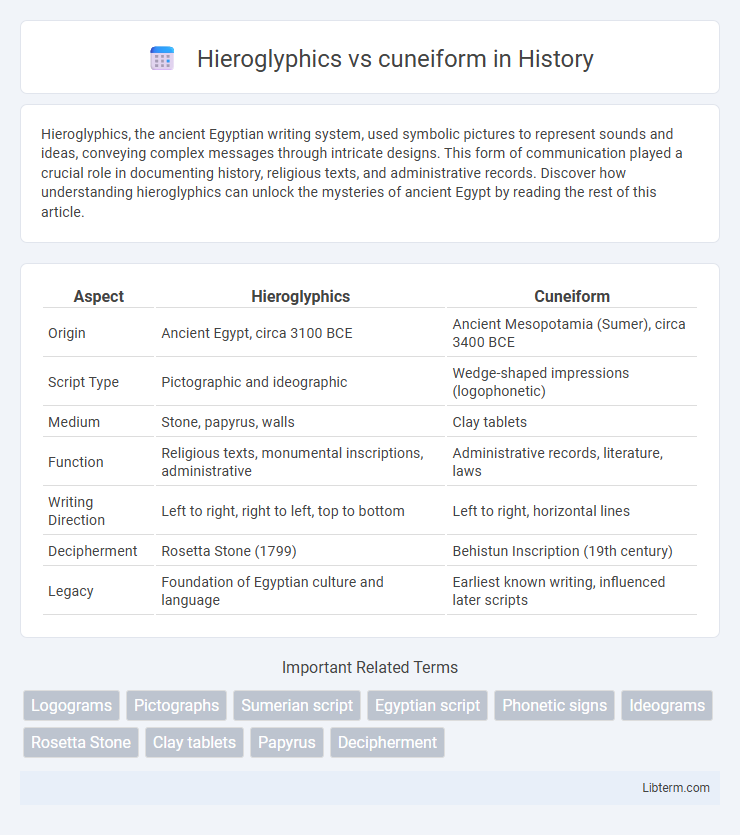Hieroglyphics, the ancient Egyptian writing system, used symbolic pictures to represent sounds and ideas, conveying complex messages through intricate designs. This form of communication played a crucial role in documenting history, religious texts, and administrative records. Discover how understanding hieroglyphics can unlock the mysteries of ancient Egypt by reading the rest of this article.
Table of Comparison
| Aspect | Hieroglyphics | Cuneiform |
|---|---|---|
| Origin | Ancient Egypt, circa 3100 BCE | Ancient Mesopotamia (Sumer), circa 3400 BCE |
| Script Type | Pictographic and ideographic | Wedge-shaped impressions (logophonetic) |
| Medium | Stone, papyrus, walls | Clay tablets |
| Function | Religious texts, monumental inscriptions, administrative | Administrative records, literature, laws |
| Writing Direction | Left to right, right to left, top to bottom | Left to right, horizontal lines |
| Decipherment | Rosetta Stone (1799) | Behistun Inscription (19th century) |
| Legacy | Foundation of Egyptian culture and language | Earliest known writing, influenced later scripts |
Introduction: Decoding Ancient Scripts
Hieroglyphics, used primarily in ancient Egypt, and cuneiform, developed by the Sumerians in Mesopotamia, represent two of the earliest complex writing systems. Hieroglyphics employ pictorial symbols to convey meaning, enabling detailed storytelling and religious documentation on monuments and papyrus. Cuneiform uses wedge-shaped marks on clay tablets, facilitating administrative, legal, and economic records that laid the foundation for early civilization management.
Origins of Hieroglyphics and Cuneiform
Hieroglyphics originated around 3100 BCE in ancient Egypt as a complex system of pictorial writing used for religious texts, monumental inscriptions, and administrative documents. Cuneiform emerged approximately 3400 BCE in Mesopotamia, primarily developed by the Sumerians for record-keeping and economic transactions using wedge-shaped marks on clay tablets. Both writing systems represent some of the earliest known forms of written communication, reflecting their respective civilizations' cultural and administrative needs.
Geographic Spread and Cultural Influence
Hieroglyphics originated predominantly in ancient Egypt, influencing the Nile Valley and Mediterranean regions through religious texts and monumental inscriptions. Cuneiform emerged in Mesopotamia, spreading across the Fertile Crescent and impacting diverse cultures such as the Sumerians, Akkadians, and Babylonians through administrative and legal documentation. The geographic concentration of hieroglyphics around the Nile contrasts with the broader Mesopotamian diffusion of cuneiform, reflecting distinct cultural roles in communication and governance.
Structure and Symbolism: Comparing the Scripts
Hieroglyphics uses pictorial symbols that represent objects, ideas, and sounds, creating a complex visual language with both logographic and alphabetic elements. Cuneiform consists of wedge-shaped marks pressed into clay tablets, primarily representing syllables and phonetic sounds in a more abstract and stylized form. The symbolic structure of hieroglyphics emphasizes detailed imagery linked to Egyptian religious and cultural concepts, while cuneiform's streamlined symbols reflect its adaptability across diverse ancient Mesopotamian languages.
Materials and Methods of Writing
Hieroglyphics were inscribed using reed brushes and pigments on papyrus, stone, and walls, requiring skilled artisans for detailed pictographic symbols. Cuneiform employed a stylus pressed into soft clay tablets, allowing rapid inscription through wedge-shaped marks that baked into durable records. These distinct materials and tools influenced the preservation and complexity of each ancient writing system.
Purposes and Uses in Ancient Societies
Hieroglyphics primarily served religious and ceremonial purposes in ancient Egyptian society, often inscribed on temple walls, tombs, and monuments to convey spiritual texts and royal decrees. Cuneiform, developed by the Sumerians, was used mainly for administrative, economic, and legal record-keeping, facilitating trade, taxation, and governance in Mesopotamian city-states. Both writing systems enabled complex communication and preserved cultural knowledge, but hieroglyphics emphasized symbolic artistry while cuneiform prioritized practicality and efficiency.
Decipherment: Unlocking the Past
Hieroglyphics, the complex Egyptian writing system using pictorial symbols, was deciphered in the 1820s by Jean-Francois Champollion through the Rosetta Stone, revealing insights into ancient Egyptian civilization. Cuneiform, developed by the Sumerians around 3400 BCE, was decoded in the mid-19th century primarily by Henry Rawlinson using the Behistun Inscription, allowing historians to understand Mesopotamian history and administration. Both scripts' decipherment marked pivotal moments in archaeology, transforming obscure symbols into readable texts that unlocked the early development of writing and civilization.
Legacy in Modern Scholarship
Hieroglyphics and cuneiform stand as foundational writing systems that profoundly shaped modern linguistic, archaeological, and historical research. Hieroglyphics, primarily used by ancient Egyptians, provide crucial insights into religious texts and monumental inscriptions, allowing scholars to reconstruct Egypt's social and political history. Cuneiform, developed by the Sumerians, enabled early record-keeping and literature, forming the basis for understanding Mesopotamian civilization and influencing the study of ancient Near Eastern languages and cultures.
Key Discoveries and Archaeological Finds
Key discoveries in hieroglyphics include the Rosetta Stone, which enabled the decipherment of Egyptian scripts by revealing parallel texts in Greek and Egyptian languages. Significant archaeological finds for cuneiform involve the ancient tablets from Mesopotamian sites such as Uruk and Nineveh, where clay tablets inscribed with wedge-shaped symbols provide insights into early writing systems and administration. Both scripts serve as foundational evidence for understanding early civilizations, recording everything from legal codes to religious texts.
Conclusion: Lasting Impact on Human Communication
Hieroglyphics and cuneiform represent two foundational writing systems that profoundly shaped human communication by enabling complex record-keeping, cultural expression, and administration. Hieroglyphics influenced art and religious texts in ancient Egypt, while cuneiform laid the groundwork for legal codes and literature in Mesopotamia, demonstrating their enduring legacy. Their development marked a critical transition from oral traditions to written history, setting the stage for modern alphabets and written languages worldwide.
Hieroglyphics Infographic

 libterm.com
libterm.com